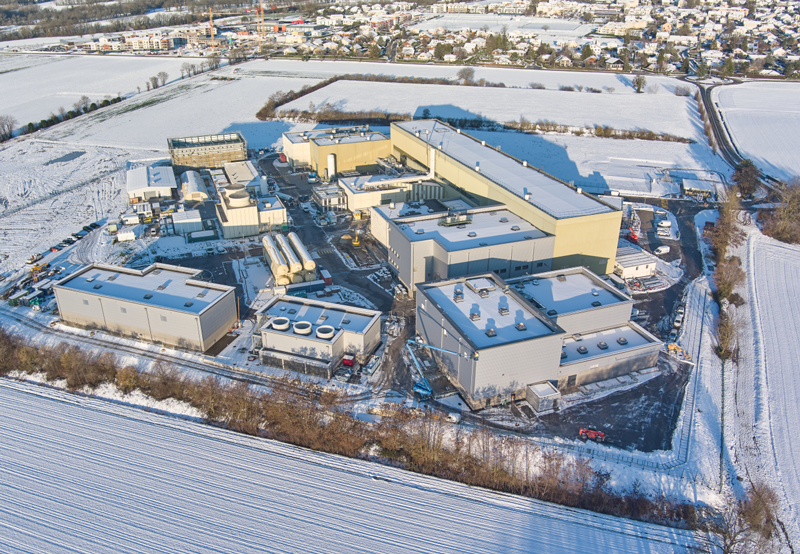 On January 20th, the civil-engineering work for the High-Luminosity Large Hadron Collider (HL-LHC), has been completed. The new equipment for the HL-LHC has required new, large, civil-engineering structures on the sites of the ATLAS experiment in Meyrin, Switzerland (LHC Point 1) and the CMS experiment in Cessy, France (LHC Point 5). On each site, the underground constructions consist of a vertical shaft around 80 m deep and 10 m in diameter; an underground service cavern (16 m in diameter and 46 m long) that will notably house cryogenics, cooling and ventilation equipment; a 300-metre-long gallery for accelerator equipment and infrastructures, including power converters, protection systems, electrical distribution boxes, beam instrumentation and accelerator controls; and four galleries measuring around 50 metres in length, connecting the new structures to the LHC accelerator tunnel. These will house specific hardware, such as radiofrequency equipment for the crab cavities, superconducting links and cryogenic distribution lines. The connection to the LHC tunnel will be made via 12 vertical cores (1 m in diameter and 7 m deep) located at the end of the connecting galleries, 6 on either side of the Interaction Point (IP), which will be drilled later and completed during Long-Shutdown 3 (2026–2028). On each site, the surface structure consists of five new buildings, representing a total surface area of 2.800 m2. These will house the cooling and ventilation equipment, cryogenic equipment, as well as electrical equipment supplying the new accelerator equipment installed underground.
On January 20th, the civil-engineering work for the High-Luminosity Large Hadron Collider (HL-LHC), has been completed. The new equipment for the HL-LHC has required new, large, civil-engineering structures on the sites of the ATLAS experiment in Meyrin, Switzerland (LHC Point 1) and the CMS experiment in Cessy, France (LHC Point 5). On each site, the underground constructions consist of a vertical shaft around 80 m deep and 10 m in diameter; an underground service cavern (16 m in diameter and 46 m long) that will notably house cryogenics, cooling and ventilation equipment; a 300-metre-long gallery for accelerator equipment and infrastructures, including power converters, protection systems, electrical distribution boxes, beam instrumentation and accelerator controls; and four galleries measuring around 50 metres in length, connecting the new structures to the LHC accelerator tunnel. These will house specific hardware, such as radiofrequency equipment for the crab cavities, superconducting links and cryogenic distribution lines. The connection to the LHC tunnel will be made via 12 vertical cores (1 m in diameter and 7 m deep) located at the end of the connecting galleries, 6 on either side of the Interaction Point (IP), which will be drilled later and completed during Long-Shutdown 3 (2026–2028). On each site, the surface structure consists of five new buildings, representing a total surface area of 2.800 m2. These will house the cooling and ventilation equipment, cryogenic equipment, as well as electrical equipment supplying the new accelerator equipment installed underground.
The completion of the civil-engineering work marks the start of the transition towards the HL-LHC era. Approved in June 2016 and due to start operating in 2029, the HL-LHC will considerably improve the performance of the LHC by increasing the number of particle collisions and thus boosting the potential for discoveries. While the LHC can produce up to 1 billion proton–proton collisions per second, the HL-LHC will increase this number, known as “luminosity”, by a factor of between five and seven. To achieve this increase in luminosity, several innovative and challenging key technologies are being developed. These include new superconducting quadrupole magnets (based on niobium–tin instead of niobium–titanium) that will better focus the beam, and compact crab cavities to tilt the beams at the collision points thus maximising the overlap of protons. Other innovations include high-temperature superconducting links, new technologies for beam vacuum (prolonging the lifetime of the magnets) and beam collimation, as well as very precise high-current power converters. Most of these HL-LHC components will be integrated at Point 1 and Point 5 of the LHC ring, where the detectors ATLAS and CMS are located.
The HL-LHC is CERN’s main scientific goal of the decade, recognised as one of the highest priorities for the field in the 2020 update of the European Strategy for Particle Physics. It is an international endeavour involving 43 institutions in 19 countries, including in CERN’s Member and Associate Member States, as well as in the United States, Canada, Japan and China.




